It’s gotten quiet around marketing’s buzzword of 2022 as everyone has moved on to marvel at and worry about AI. Which, of course, isn’t a surprise – but a bit of a shame. While our obsession with buzzwords (and the new) rarely do our industry or our reputation any good, the ambition of creating brands that have a more positive impact on normal people’s lives – i.e. adding more value rather than only extracting it – is something every marketer should aspire to do more often.
I’ve written about community, what defines them, and how they are (potentially) valuable for businesses and brands – so it won’t come as a surprise that I believe that there’s some valuable lessons to be learnt for marketers. A few people have asked whether there are more concrete, tangible frameworks that I’ve encountered or come across: how can marketers create that kind of value?
The answer is, of course there are. Zoe Scaman’s flywheel, David Spinks’ book, Joel Goodhall’s 3 E’s for sports marketing, are just a few examples and good starting points.
Today I’m going to add to this collection with a framework that I’ve started to develop with the help of Simon Domone while heading up strategy at ScienceMagic – and that I have slightly updated since. Here are The Six I’s of Connection.
In An Ideal World…
This framework was developed with the ambition to guide strategic and creative processes and the development of tangible initiatives that connect brands and communities.
While the original intent was to find a model that enables brands to build communities around them, I quickly came to the conclusion that a more actionable and useful framework would help brands to tap into existing communities. The underpinning assumption is (a) most communities don’t give a shit about brands and will exist without them, and (b) that some brands can make a meaningful contribution to a community’s cause.
Like all good frameworks it’s basically a Venn diagram. Two humble circles – one for brand, one for community – and an area of overlap. No big surprises here. The true magic, however, begins in that space. So let’s get into it.
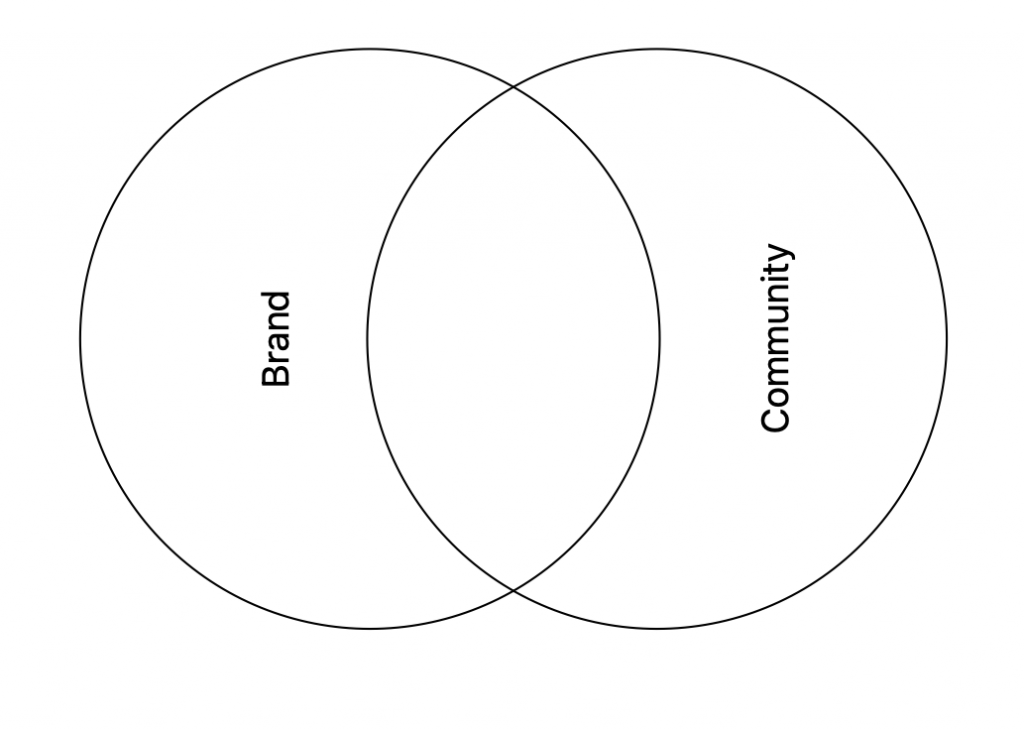
Getting to a Shared Ideal
In order for a brand to connect to a community, there are three things they need to understand.
Firstly, they need to be clear about their brand mission. There’s lots of ways of going about it and entire books and classes and online courses have been given not that topic. The simplest way of going about this is to answer what the thing is you do unlike any other? “Do” means action.
Secondly, they need to understand what the community wants. Communities are groups of people united by a shared ambition – they are working towards a shared goal. What is that goal?
Lastly, they need to identify how these two things overlap and reinforce one another. This is the “Shared Ideal” that exists between a brand and that community. A place where they can help each other out, a win-win (and maybe even a win-win-win, depending on the community’s ambition.)
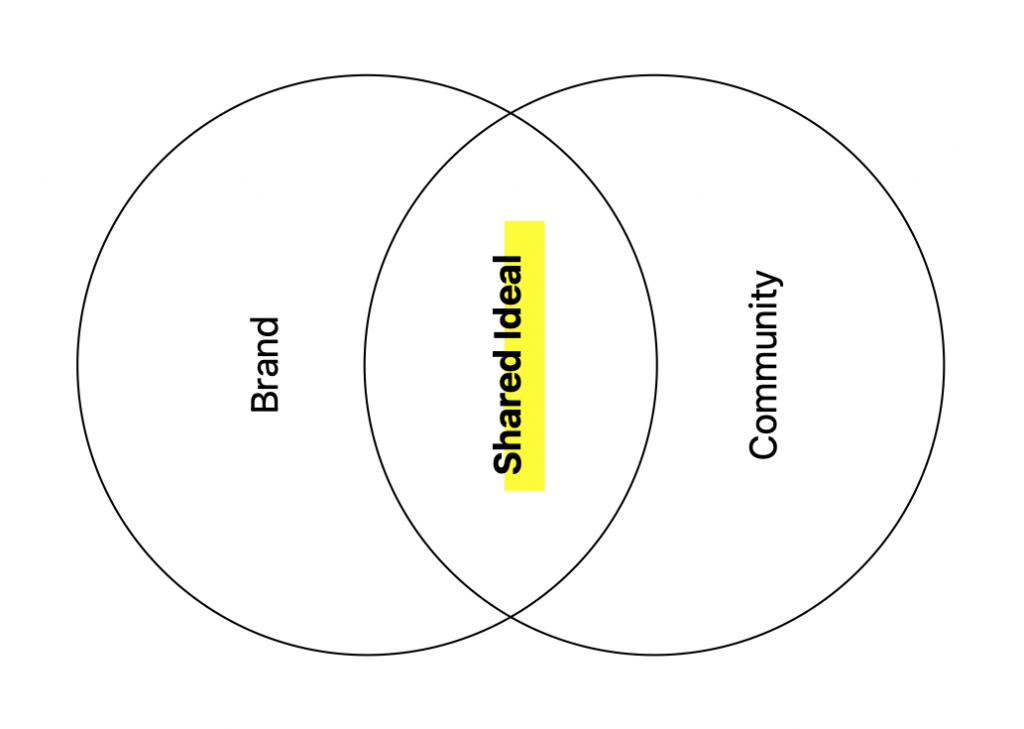
Five Dimensions of Connections
Once this groundwork is done, they can start designing and building the connection between their brand and the community.
This connection can be designed across five dimensions. These dimension are Incentive, Identity, Interaction, Influence, and Impact. The better these dimensions are developed for an initiative, the more likely that people don’t just experience a (functional) benefit but, best case scenario, a sense of belonging.
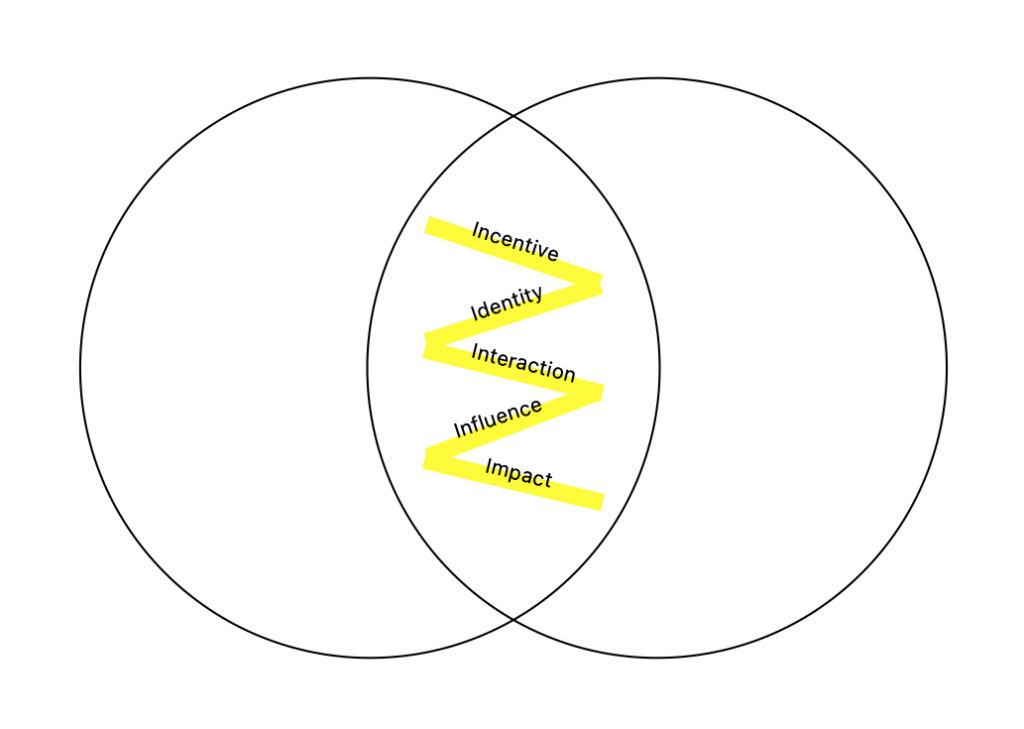
Incentive.
The first dimension is all about what people get from entering the relationship, or engaging with the brand, the event, the experience. What is in it for them? This might sound transactional, but it helps thinking about creating real value for people. That value, though, doesn’t have to be material. What is it that makes people reach out in the first place? Note that this incentive may change over time and gradually shift from a more functional to a more emotional incentive: the incentive of physical fitness offered by Crossfit being enriched by the resulting camaraderie.
Examples: the incentive to going to Mumsnet is answers to burning parenting question at ungodly hours of the day; the incentive to join Peloton, in the first instance, is improving one’s fitness; the incentive to join a book club is discovery of new (meaning in) books.

Identity.
The next dimension is about identity – and how an initiative allows members of a community to signal their membership, their knowledge, and ultimately identity. Does the initiative help members of the community express their identity? Is it visible to the in-group and does it create distinction from the out-group? Can they take something home with them that marks the moment – and makes it more exclusive and a more worthwhile signal?
Examples of this can be simple membership cards (think SOHO house) or tiered membership options (e.g. silver, gold, or platinum credit cards); it can be the Rapha RCC gear only available to members; the New Yorker totebags; a digital/virtual collectible; or something as little as Discord channel ranks.

Interaction.
The next dimension looks at the levels of interaction enabled by this initiative. How does the activation enable members of the community and the brand to interact? Does it create a space for them to convene? It’s an old truth, but one-way broadcasting from brand to community isn’t conducive for deeper relationships and connection – it’s a sign of ignorance and disrespect on behalf of the brand.
Those spaces don’t have to be physical (although there are merits for them to be) and they don’t have to be owned by your brand (although there are merits for them to be.)
Examples for interaction can be well-run social channels where brands engage in real conversations (simple polls can do the trick); it’s Rapha’s clubhouses where cyclists come together for a post-ride coffee and chat; it’s the Discord channel of Strands of Genius; it’s your favourite airline’s Frequent Flyer Lounges (though they’re often not seen through that lens.)

Influence.
The next dimension is influence and looks at the extent to which an initiative allows for a community to exercise true influence over the brand’s actions (e.g. their product, their experience, etc.) How does the activation enable people to influence the brand – and vice versa? Where there is no influence, there is no community, only a bunch of passive spectators. If the community can’t shape the experience, it’s a transaction, not a relationship. Can the community (re)direct funds? Do they get a say in product development? Can they make (at least) suggestions?
Examples: Microsoft’s Halo working with communities to improve representation in gaming; Dove working with afro hair library to create more representative characters in the digital world.

Impact.
The final dimension looks at the impact of an initiative. How does the relationship help the cause of the community? Is it aimed at making a tangible difference in the world? (How) will the activation help make steps towards it? It doesn’t necessarily lead to a solution of the problem – but there should be a meaningful, measurable contribution.
Examples for real impact can be Patagonia donating Black Friday proceeds, filing policies, or supporting grassroots groups; it can be adidas getting runners out to clean beaches of plastic to be turned into new running shoes; Rapha getting more people to cycle; or Nike and Dove keeping more girls in sports.
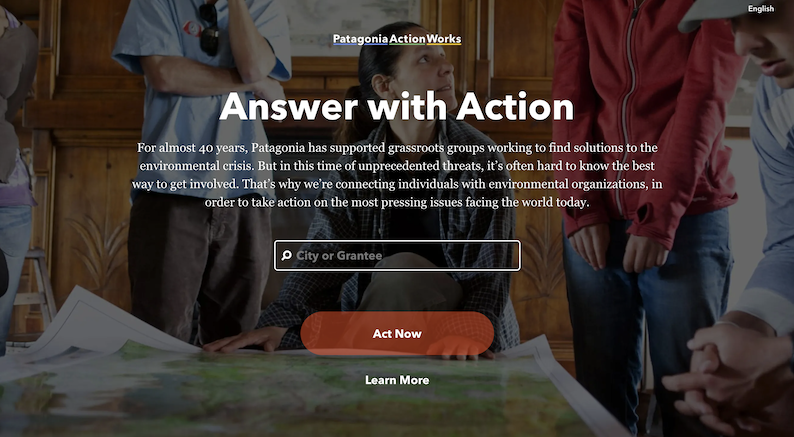
Applying the framework
That’s it. One Shared Ideal and five dimensions of connection nestled into the cosiness of a Venn diagram. A simple framework: actionable, not academic; built for pace, not perfection. This is the Six I’s of Connection.
There are probably a few things that are wrong with this model. But there’s also a few things this framework is good at. We have only played around with a few different ways – but found it both useful for analysis of existing brand activities in their ability to create connection and in ideating new activities.
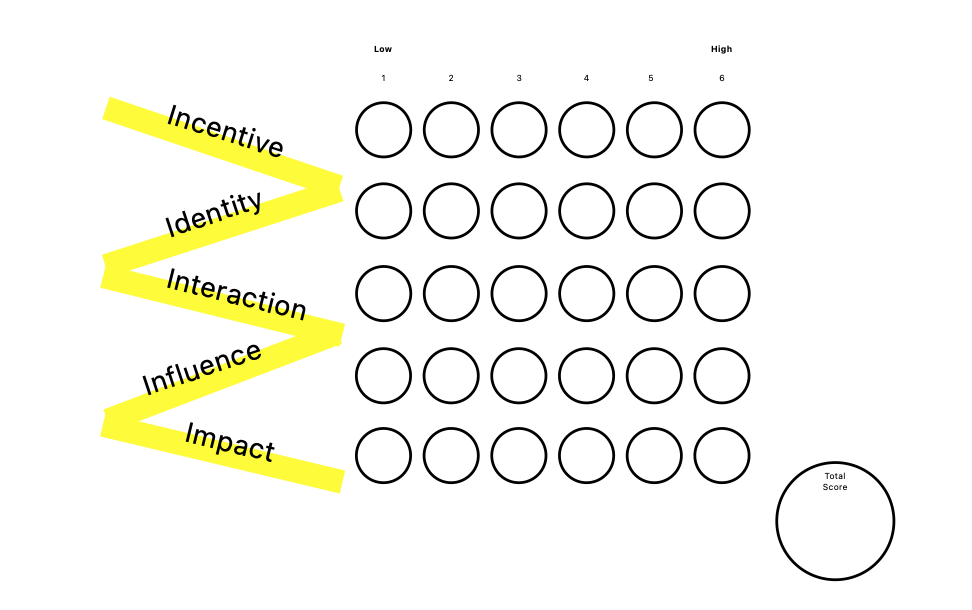
Analysis & workshopping
Firstly, it’s a simple way of assessing a brand’s existing connections to a community. It helps to prepare yourself when meeting with (potential new) clients and have a more structured conversation.
Turning the framework into questions can also turn it into a interactive workshop exercise helping create alignment, surface disagreement, and highlight those areas where action needs to be taken.
- Do we have credibility (through product or services) to contribute to a community’s ambition? (Shared Ideal)
- To what extent do your different brand activities support this Shared Ideal?
- Is there enough incentive to join? (Incentive)
- Do you enable the expression of identity? (Identity)
- Are you enabling people to have meaningful interactions? (Interaction)
- Can they exert influence over (elements of) your brand? (Influence)
- Do these activities create a bigger impact? (Impact)
Creative Ideation
Secondly, it’s a useful way to guide ideation for campaigns or activations. It helps you hone in on a territory for your idea – sitting snuggly between what your brand is best at and what your community wants most.
Then, once you have your big idea and expression sorted, the framework can help you fine tune campaign expressions and optimise their potential for connection.
Some of the questions you might ask yourself:
- Does your idea put your brand into service of the community? (Shared Ideal)
- Do we need to be clearer about what’s in it for people? (Incentive)
- How can we dial up the badge value? (Identity)
- Can we make the initiative more interactive, can we get people to engage with each other more? (Interaction)
- How can we give people more of a voice in the activation? (Influence)
- How can we gear the activation more towards the desired impact? (Impact)
Six I’s of Connection
The Six I’s of Connection, as any framework, isn’t perfect. It’s a tool to enable thinking, not to replace it. It’s geared towards action, not perfection.
There might be more application to the Six I’s of Connection – but these two have proven helpful and led to some interesting ideas on meaningful projects: it can help find and articulate a territory where your brand can make a meaningful contribution – and then develop the optimal expressions.
I hope this answered some of the questions I got after my last article. (Incentive) If you read this far, why not share this article to signal to your community that you’re deeply in the know? (Identity) What do you think? (Interaction) What would you change? (Influence) Go try it out and let me know if it helped. (Impact)
That’s it from me on the topic and theory of community. Now back to the action.







Leave a Reply